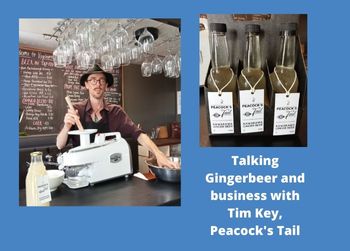But listen — if you’re feelin’ dry,
Just see there’s no one near,
And go and wink the other eye
And ask for ginger beer.
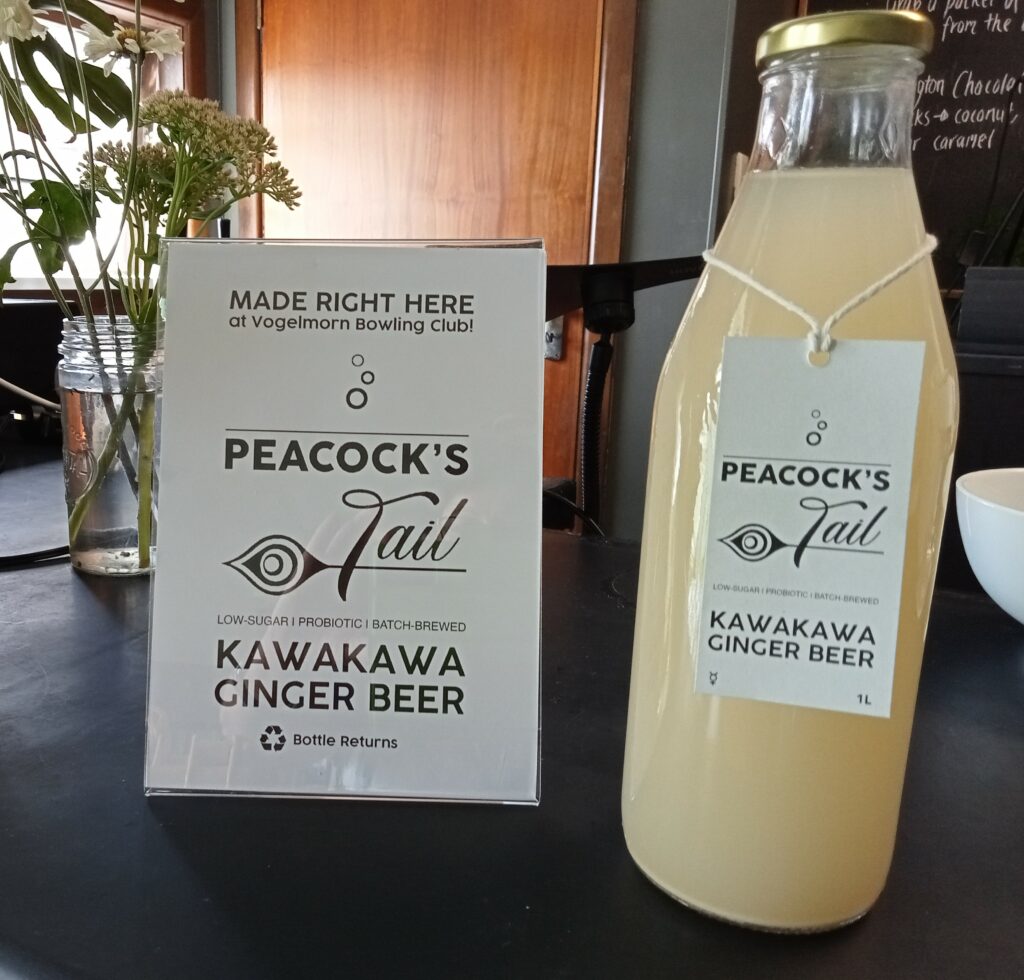
This week in our Business blog we acknowledge International gingerbeer day, recognised on 13 March. We delve into the history of gingerbeer brewing in Wellington City and talk to one of Wellington’s newest ginger beer brewers, Tim Key of The Peacock’s Tail.
Ginger beer – a refreshing beverage resulting from the fermentation of ginger, sugar, yeast and water – is believed to have originated in the Britain around the mid-1700s, taking advantage of the increased trade in goods like sugar and ginger from the Caribbean and India. Usually it was bottled in sturdy, earthenware bottles that allowed for wide distribution.
It’s not surprising then, that no sooner had the first Pākehā settlers arrived on the shores of Te-Whanganui-a-Tara and they began using natural springs to brew a range of alcoholic and non-alcoholic beverages. Gingerbeer was one of the many beverages popular with the new immigrants and the first recorded brewers in the fledgling settlement believed to be John Osborne (Osborne and Co) and John Roots both of whom were documented as being merchants or manufacturers of gingerbeer by 1843.
As the colony grew so too did the number of manufacturers of “aerated waters, cordials and syrups” all of which made up the broader “softdrinks” (ie those without alcohol). While some businesses flared and died within a short period of time, others became generational and established a solid reputation for product quality and service.
It was these family run operations that sometimes gave some women an opportunity to move into the business world, albeit due to the necessity of needing to support themselves and their families on the untimely death of their husbands.
Colonial life was harsh and Mary Roots took over John’s business following his demise a few years after establishing his business. Also continuing on, and successfully expanding, the family business was Emma Dixon (Mrs Geo Dixon), following the death of her husband George. George had in turn earlier taken over the aerated water and ginger beer manufacturing company started by his father Edward (who was ably assisted by wife Catherine) in the mid-1850s. Other of Edward and Catherine’s offspring either branched out into starting cordial businesses in the Manawatu, Wairarapa or Nelson (for the sons) or, in the case of their daughters, married into manufacturing families. Emma Dixon eventually sold the business to a competitor company, Bennet and Ready in 1897 and they in turn continued manufacturing softdrinks until 1920.
Around the same time as the Dixon business was established Thomas Cooper, and eventually his son George, ran an aerated water business first in Molesworth Street and then Thorndon Quay, continuing production for over thirty years.
Other names that became brands associated with the brewing of gingerbeer in Wellington included the Strikes who formed numerous companies over a forty year period.
Thomson and Co was a respected business that began in Dunedin, and through partnership, expanded operations into Wellington. Becoming Thomson and Lewis in the late 1880s, the company Thomson Lewis and Co. still has registered offices in Ngauranga. A remnant of Thomson Lewis manufacturing can be found in the well at the entrance to Moore Wilson’s in Te Aro. 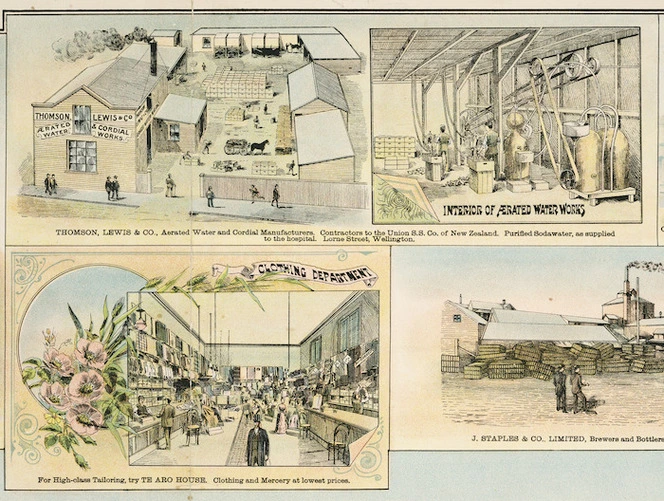
F W Niven & Co. :[Thomson, Lewis & Co., Te Aro House. 1895]. F W Niven & Co. :View of Wellington N Z [ca 1895] from Aurora Terrace. F W Niven & Co. [lith] Ballarat, [Victoria, ca 1895]. Ref: D-002-005-002. Alexander Turnbull Library, Wellington, New Zealand. /records/23007862
The big brand international names of Schweppes and Coca-cola moved onto the Wellington softdrink manufacturing scene in the 1930s.
Ginger beer remained a popular refreshment, particularly with those who abstained from alcoholic drinks, until some time after the Second World War, when popularity began to wane.
The 1990s saw a resurgence in popularity of the ginger brew as noted in this article in City Voice from July 1995.
Throughout the decades there have been as many as 70 different Wellington gingerbeers.
Tim Key, a musician and self-described Fizz Whizz, and his Peacock’s Tail kawakawa infused gingerbeer are the latest to join the long list of Wellington gingerbeer brewers.
With the increased popularity in fermentation and its health benefits, along with a growing interest in alcohol free drinks we are again seeing a revival in gingerbeer and it was both these things, along with a desire for a less heavily sweetened drink, that led Tim Key to begin experimenting in his kitchen several years ago.
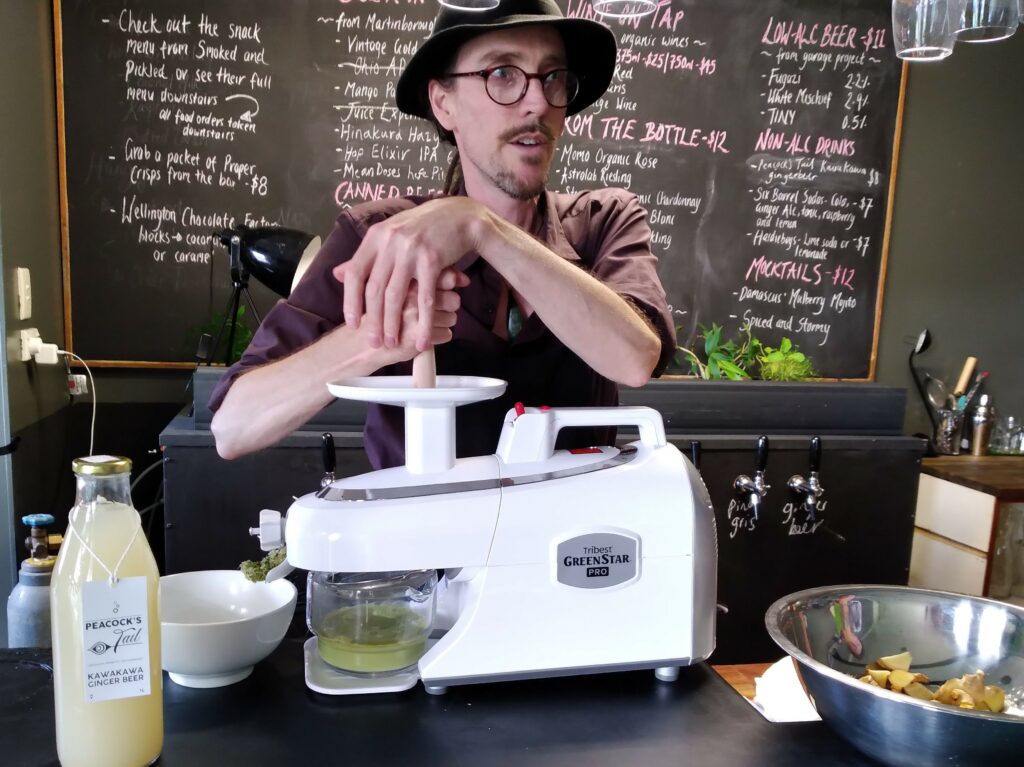
Tim operates his small batch gingerbeer brewing business out of the Vogelmorn Bowling Club community centre, where he first began offering his product through the on-site cafe before venturing into wider sales via his website.
The name, Peacock’s Tail is, Tim advises a reference to its symbolism in alchemy and in turn the fermentation process the gingerbeer ingredients go through to become the end product.
Using the juice of freshly pressed root ginger, and infusing it with several leaves of kawakawa, Tim has arrived at a brew that is a dry, warming and refreshing addition to the non-alcohol options available locally.
Gingerbeer isn’t Tim’s first venture into beverage production having been involved in the start up of a chai manufacture some years previous.
Assisted by his daughter Ela who oversees the bottle labelling after school, Tim’s gingerbeer is a unique, 21st century addition to a manufacturing industry that has a long history in Wellington.
Watch our video as we talk to Tim about making gingerbeer and future plans to grow his business.
If you want to know more, check out some of Wellington City Libraries’ historical resources and some of the books we have that might encourage you to begin your own brewing.
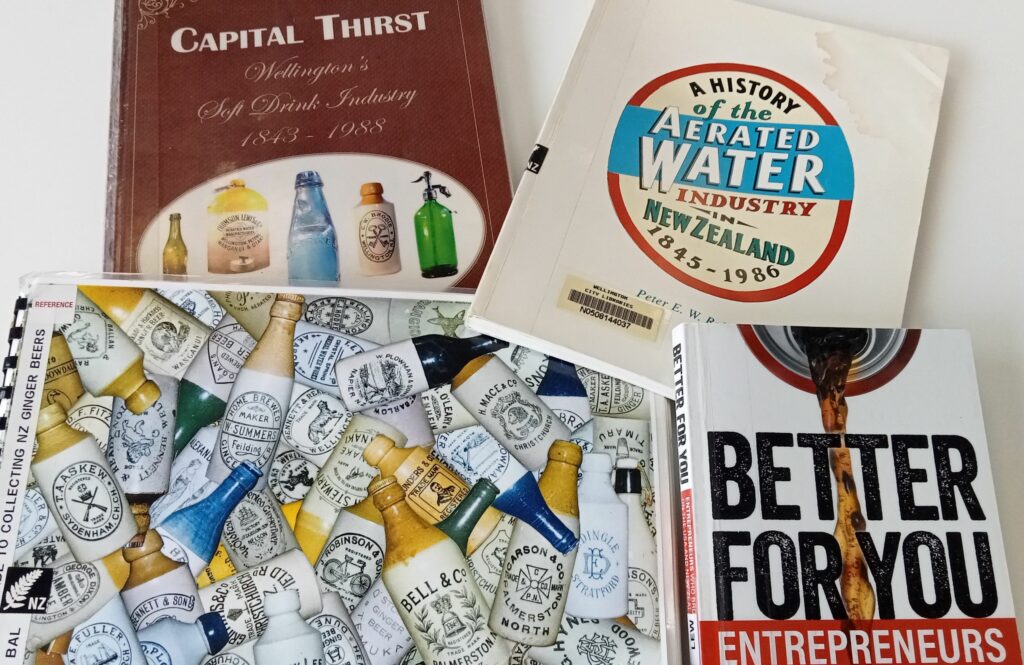
A pictorial guide to collecting New Zealand ginger beers / Baldwin, Bruce
“Lists every New Zealand ginger beer bottle known to date, March 1996″–Pref.” (Catalogue)
- NB: This item is in the Heritage Collection and is available only for in-library use.
The aerated water and soft drink industry in New Zealand, 1845-1986 / Robson, Peter E. W
- The origins and early development of the industry –The soft drink industry in New Zealand — Further developments in the industry — The N.Z. Soft Drink Association.
- NB: This item is in the Heritage Collection and is available only for in-library use.
Capital thirst : Wellington’s soft drink industry 1843-1988 / Fisher Peter
Traces the development Wellington’s softdrink manufacturing industry through bottles.
Better for you : entrepreneurs who broke big soda’s stranglehold on the USA and New Zealand / Lewis, Lisa A.
“In Better for You, Lisa A. Lewis examines the rise of a global healthy drinks market and presents profiles of entrepreneurs who dared to create innovative “better for you” beverages in two distant countries”–Back cover.” (Catalogue)
Kombucha & co : tips & recipes to make your own kombucha, kefir, jun, ginger beer, honey mead & more / Evans, Felicity
“Kombucha and other fermented drinks are great for gut health, but they’re expensive to buy and you can’t be sure of the quality. But it’s easy to make your own kombucha when you know how. Fermentation guru Felicity Evans has you covered with step-by-step instructions to make a range of 50 delicious flavours of gut-friendly probiotic drinks, including troubleshooting tips and inspiration for alcohol-free happy hour at home. From kombucha to kefir, ginger beer to honey mead, learn to confidently make your own fermented drinks and transform your health from within.” (Catalogue)
Wild drinks : the new old world of small-batch brews, ferments and infusions / Flynn, Sharon
“Wild Drinks is the definitive book on infusing, brewing and fermenting delicious and often nutritious things to drink, from mead to kombucha to cider to kvass. With the entertaining and assuring voice of fermentation expert Sharon Flynn, it is a perfect jumping off point for anyone who is curious to learn more about this magical and witchy world. Across six chapters, Wild Drinks features more than 60 recipes. Learn the basics of wild fermentation and read about the equipment you need to start your fermentation journey. Discover drinks made from grain, including doburoku (farmhouse sake), wild beer and kvass; explore recipes for wild apple cider, country wine and wild soda; try water kefir, kombucha, ginger beer and fruit vinegars, and come to understand the art of imparting flavour, from shrubs to flavoured waters to syrups and liqueurs. And in the spirit of reducing waste, the final chapter shows how to use fermentation byproducts – ranging from crackers made from sake lees to kimchi pancakes, nettle risotto and Basque cider chicken. Recipes include fascinating historical context and quick tips, and Sharon considers the traditions associated with these ancient fermentation practices too”–Publisher’s description.” (Catalogue)
Probiotic drinks at home : make your own seriously delicious gut-friendly drinks / Evans, Felicity
“Take the next step after green smoothies, with probiotic drinks for gut health. From kombucha to kefir, ginger beer to honey mead – learn to confidently handcraft your own beautiful elixirs and transform your health, one ferment at a time. Fermentation guru Felicity Evans provides step-by-step instructions to make a range of 50 delicious probiotic drinks. Including expert guidelines and troubleshooting tips so that you ll soon be brewing delicious drinks to make your gut happy.” (Catalogue)
If you need more information please contact the Prosearch team at the library. We can help you find information across a range of perspectives and resources. All enquiries are treated in confidence.


